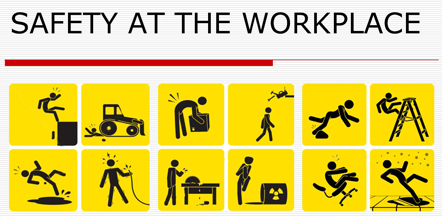Workplace safety and health promotes brand image
by Timothy Edwards
The World Day for Safety and Health fell on Thursday, April 28.
It is a good sign nowadays, to see companies giving greater
prominence to Occupational Safety and Health Management (OSHM). OSHM
hinges on three cornerstones: standards, good practices and legislation.
In all these, the senior management's commitment plays a crucial part in
ensuring a workplace that upholds the health and safety standards for
everyone who comes in contact with the business,
Proper health and safety management systems ensure excellence at
workplaces. If we analyse some industrial and road accidents in the
recent past, we see that many of them could have been avoided, if human
behaviour, attitude and safety culture had been practised. We should
take steps to promote healthy human behaviour, attitude and safety
culture with OSHM practices.
|

Pic: Courtesy betterimages.wordpress.com |
Companies which have OSHM as one of their key competencies, improve
brand image in the eyes of their stakeholders, internal and external.
This we see in some of the brands that are held in high esteem,where key
OSHM competencies are deeply embedded in their culture and in all their
interventions.
Their holistic approach towards safety encompassing core areas make
them stand out. These core areas include good management, well defined
safety procedures and goals, safety and health competency overseen by
managers, having systems and processes in place to learn from accidents
and internal audits to manage risks.
Major role
How can human resource practitioners contribute towards OSHM? Human
Resources must play a major role by determining:
*Whether staff is adequately trained in OSHM systems and processes
* Whether the organisation is sufficiently staffed
* Whether staff is prevented from working continuous shifts without
mandatory breaks
* Whether the workload is divided according to the skills and
competencies of staff.
Failure to observe these may lead to compromising OSHM situations.
When visiting hotels in Sri Lanka, one may observe beautiful and
well-built hotels, but their general day-to-day operations are in
disarray. In many hotels, the toilets are not clean and the area where
food is served infested with flies. It would be interesting to find out
how ad hoc recruitment is conducted by some hotel managers without
adhering to a proper recruitment and selection procedure. In one
instance, a handyman, who went to attend to some repairs in a hotel,
ended up filling an urgent vacancy in the kitchen department. Resorting
to unconventional recruitment methods to meet urgent manpower needs may
work adversely in the long run.
Although, we can fully empathise with employers because of the dearth
in finding suitably skilled personnel in this sector, situations like
these, serve as classic examples to show how failing to employ people
with the right technical skills, attitude and behaviour can compromise
OSHM standards and strategies in establishments.
Change agents
We are familiar with the many hazardous conditions that prevail in
industries which are ergonomically not conducive for workers. For
example, in the garment sector, there are factories where employees
perform tasks standing all day-long in highly hazardous conditions.
Although immediate remedies cannot be found for situations like
these, the human resource practitioners in these factories should take
on the role of change agents and usher in ergonomically conducive work
environments.
Leadership
It is evident that shared leadership models are important in
implementing successful OSHM strategies. For example, in the
construction sector, OSHM principles and policies should be regulated
and implemented rigidly.
It is a common sight to see road development staff working without
proper protective gear in hot and humid conditions. Construction sites
are no different. Despite these drawbacks, it is encouraging to see the
authorities correcting these lapses, such as having a safety officer at
all construction sites.
Therefore, OSHM boils down to having appropriate work systems and
processes which are steered by a leadership that gives adequate
attention to quality, effective policies and proper regulation.
To create an organisational culture that is embedded with OSHM
principles, the leadership should influence all layers of an
organisation; Allocate sufficient resources, including time and manpower
to complete tasks safely and successfully; Develop a good understanding
of how human-technology interactions take place, and take note of high
risk factors, human performance, task planning and technology. Then your
organisation will be on the road to success.
The writer is a trainer, human resources practitioner and business
consultant.
|

